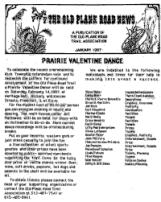8. Rails-to-Trails Conversion
It only took 6 years to build the Joliet and Northern Indiana railroad. The original plank road
company was formed in 1849 and the inaugural run of the railroad was in 1855. It took over 20 years
to unbuild the railroad. Railroad service had been discontinued for 4 years when many Penn Central
rail lines were taken over by Conrail in 1976. It was at this time that the first moves were taken to
buy the right-of-way and convert it
to other uses. It took 20 years to
get the job done.
In 1975 when the abandonment
story hit the papers, the Will
County Forest Preserve District
organized a group of 14 municipalities to submit a federal Land and Water Conservation grant
request. The request was turned
down.
In the late 1970s area residents
started using the abandoned
railroad as a walking trail. Around
the same time the "Illinois Natural
Areas Inventory" brought to light
the extent of original prairie
remnants along the abandoned
right-of-way. In 1980 a Trail
Association was formed by a group of Park Forest citizens. Carl Glassford, a Homewood resident,
was elected the first director.
In 1982, Craig Hullinger, a planning consultant who worked for both Will County and the Village of
Frankfort and Bob Sullivan from
Orland Park produced a plan for
the right-of-way. Hullinger was
concerned that the project name,
"Abandoned Penn Central Railroad Right-of-Way," didn't have the magic to stir men's souls.
Recalling the "Oswego and Indiana Plank Road" name that had been proposed for the route in 1849,
they decided to call their new plan the "Old Plank Road Trail."
That same year, 1982, Tom Hahn started working at the Openland Project in Chicago. It was
associated with a conservation group called CorLands. One of the first things Tom did on his new job
was to give a talk about the
proposed OPRT. Hahn was
intrigued by the trail proposal and
decided to have the Chicago Title and Trust company do title searches on the original deeds to the
right-of-way property. The title company discovered reversion clauses in the original deeds that they
thought might impede a rail-trail conversion.
The next group to get involved in the trail project was the Illinois Department of Transportation
(IDOT). They investigated
condemning the right-of-way and
building a bikeway.
In the mid-eighties local
opposition to the trail surfaced and became organized. Vocal opposition and some lobbying in
Springfield appeared to cool IDOTs support for the trail. Later in the decade, local voters passed a
non-binding referendum opposed to using tax dollars for a trail.
As the opposition grew, supporters of the trail also decided to organize. The Sierra Club, local
conservation groups, and The
Nature Conservancy became more
involved. A special support group
called the "Old Plank Road Trail
Association," was formed to raise
public awareness, publish a
newsletter and organize special
events.
In response to local
opposition, IDOT disengaged from trail acquisition activities in Will County and concentrated on the
Cook County portion. Then in 1988 Will County voters approved a referendum for a $50 million
bond issue for forest preserve land acquistion. The funding to buy the trail property was in place.
The Old Plank Road Trail
Management Commission was
formed in 1988 to coordinate the
activities of the five governments
along the right-of-way (Park
Forest, Matteson, Frankfort, Rich
Township, and the Will County
Forest Preserve District).
Citizens continued to agitate
against the trail with legislators in
Springfield. In 1991 the Illinois
Legislature responded by drafting
a law restricting the powers of
county forest preserve districts.
Before signing the bill, Governor
Jim Edgar amended the draft
because he thought it restricted
forest preserve district powers too much.
In 1992 the Will County Forest Preserve was awarded a $1 million grant from the Illinois Bicycle
Path Grant Program. The 20-mile stretch of Penn Central right-of-way was finally bought for $3.4
million in December of 1992.
An Illinois Transportation
Enhancement Program (ISTEA)
grant of $1,662,935 was awarded
for trail development costs by
IDOT in 1993 and another
$200,000 was received from the
Illinois Department of
Conservation's Bikeways program.
Ground was broken for trail
construction during the summer of 1996 and the first 12 miles were paved by the next spring.
On April 3, 1997 the CorTen steel bridge over U.S. 30 was installed to connect the OPRT to the
Hickory Creek Preserve and on
July 19 the trail was opened for
use with a progressive ribbon
cutting along the trail.















Old Plank Road Trail
A 22-mile recreation and nature trail in northeastern Illinois



















